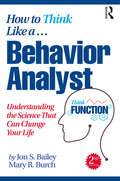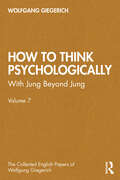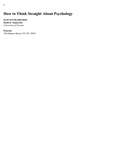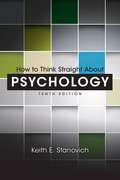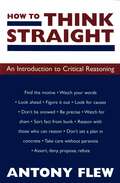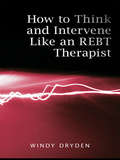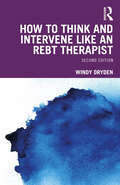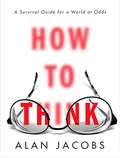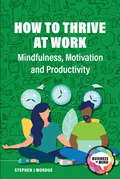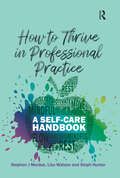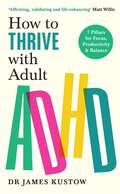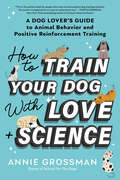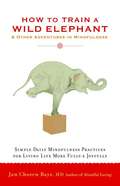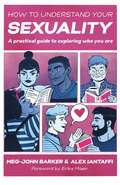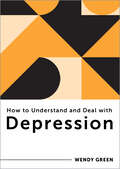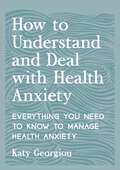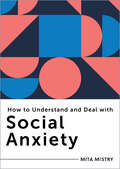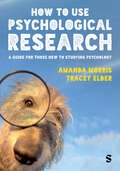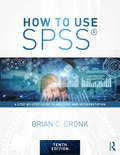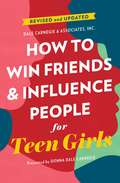- Table View
- List View
How to Think Like a Behavior Analyst: Understanding the Science That Can Change Your Life
by Jon S. Bailey Mary R. BurchHow to Think Like a Behavior Analyst is a revolutionary resource for understanding complex human behavior and making potentially significant quality-of-life improvements. Practical and clearly written, this second edition addresses basic questions like how behavior analysts work, why specific methods and procedures are used, what alternative "fad" treatments are, and more. The updated text answers 70 frequently asked questions about behavior analysis using an accessible question-and-answer format. Each question now includes a Quick Take, which is a simple and easy-to-read answer to the question, and then a more in-depth Technically Speaking answer that is more challenging. A brand-new chapter discusses ways of advancing one’s career in the field and how to go to graduate school and become board certified. This text is written for all professionals concerned with behavior, including undergraduate students in psychology and behavior analysis, parents, teachers, employers, and employees. The book can easily be used as a supplement to primary texts in introductory psychology courses, and the exercises that follow each question can be used to stimulate lively discussion in role-play and other active learning situations.
How to Think Psychologically: With Jung Beyond Jung (The Collected English Papers of Wolfgang Giegerich)
by Wolfgang GiegerichThis book discusses the psychological understanding of, and approach to, various central questions and aspects of psychological reality, in each case critically examining under what conditions one’s interpretation qualifies as 'truly psychological', i.e. fulfilling the criteria of a rigorous notion of psychology in the Jungian tradition.Providing groundbreaking new insights into psychological theory, Giegerich explores many different topics such as the origin of the notion of the soul (psychē), the rise of monotheism, the psychological significance of Christianity in Western history, the inner, above all tautegorical structure of myth and the soul’s relation to external reality, amongst others. Sometimes surprising and at times challenging, but always concretely based and carefully explained and argued, this book will provide readers with an accessible demonstration of the methodological stance of psychology as the discipline of interiority.This will be of great interest to the Jungian community, psychotherapists and psychoanalysts training in Jungian theory and practice, as well as those interested in psychological, theological and philosophical issues.
How to Think Straight About Psychology
by Keith StanovichWidely used and highly acclaimed, How to Think Straight About Psychology introduces students to the critical thinking skills they need to independently evaluate psychological information. Students will learn to analyze psychological claims found in the media, distinguish between pseudoscience and true psychological research, and apply psychological knowledge to the world around them. <p><p>The 11th edition covers an extensive range of new topics and examples illustrating psychological principles, pseudoscience, and issues obscuring the real and growing knowledge base in the field of psychology.
How to Think Straight About Psychology (Tenth Edition)
by Keith E. StanovichKeith Stanovich's widely used and highly acclaimed book presents a short introduction to the critical thinking skills that will help students to better understand the subject matter of psychology. How to Think Straight about Psychology, 10e helps students recognize pseudoscience and be able to distinguish it from true psychological research, aiding students to become more discriminating consumers of psychological information.
How to Think Straight: An Introduction to Critical Reasoning
by Antony FlewPractical reasoning and clear thinking are essential for everyone if we are to make sense of the information we receive each day. Being able to quickly know the difference between valid and invalid arguments, the contradictory versus the contrary, vagueness and ambiguity, contradiction and self-contradiction, the truthful and the fallacious, separates clear thinkers from the crowd. How to Think Straight lays the foundation for critical reasoning by showing many ways in which our thinking goes awry. Celebrated philosopher Antony Flew entertainingly instructs on the many and varied faults that occur in argument, the power of reason, how to challenge assertions and find evidence, and how not to be persuaded by half-truths. Flew also examines poor reasoning, and why we should be concerned with finding the truth. Lucid, terse, and sensible, with study questions and exercises to help along the way, this enlightening second edition will help you develop the skills necessary to argue and reason effectively by following a few simple, easy-to-remember directions.
How to Think and Intervene Like a Single-Session Therapist
by Windy DrydenTherapists new to Single-Session Therapy (SST) will often struggle to bring the SST mindset to the work and will in turn struggle to help their clients get the most out of the time that they choose to spend together.How to Think and Intervene Like a Single-Session Therapist provides the trainee with an opportunity to discover how experienced therapists think, and how their thoughts influence their interventions within the single-session context. Presenting SST in a way that both interests conventional therapists and shows the potential of this way of delivering therapy services, Windy Dryden details the multiple levels of thinking and intervening that go into single-session practice. He covers the orientation thinking experienced SST therapists have about the work when they are not doing it, the pre-session thinking they engage in while actively preparing to do the work, and the in-session thinking they engage in while doing the work. The book outlines the theory behind SST and the ways those ideas form its practice, using clinical vignettes and case scenarios to demonstrate how single-session therapists can make the best use of the limited time with their clients. The book additionally presents an ongoing dialogue between an SST therapist and a conventional therapist to highlight the thinking of the former and how the criticisms of SST by the latter can be responded to.This highly practical guide will be essential reading for any therapist who is new to or has recently been introduced to the practice of SST.
How to Think and Intervene Like an REBT Therapist
by Windy DrydenTrainee therapists often stick rigidly to the therapeutic guidelines that are taught to them on their training course, or adopted from a book, regardless of their approach. How to Think and Intervene Like an REBT Therapist provides the trainee with an opportunity to discover how experienced therapists think, and how their thoughts influence their interventions when using REBT. In this book, Windy Dryden compares the thinking and intervening characteristics of experienced REBT therapists with the actions of trainees making errors typical of people at an introductory level. By using clinical vignettes, case scenarios and verbatim dialogue he demonstrates how REBT therapists can make better use of the work alliance between themselves, their clients and their trainees, and use REBT more flexibly in practice. This highly practical guide will be essential reading for all those who have recently been introduced to rational emotive behaviour therapy.
How to Think and Intervene Like an REBT Therapist
by Windy DrydenTrainee therapists often stick rigidly to the therapeutic guidelines that are taught to them on their training course, or adopted from a book, regardless of their approach. How to Think and Intervene Like an REBT Therapist provides the trainee with an opportunity to discover how experienced therapists think, and how their thoughts influence their interventions when using Rational Emotive Behaviour Therapy (REBT).In this book, Windy Dryden compares the thinking and intervening characteristics of experienced REBT therapists with the actions of trainees making errors typical of people at an introductory level. By using clinical vignettes, case scenarios and verbatim dialogue, he demonstrates how REBT therapists can make better use of the working alliance between themselves, their clients and their trainees, and use REBT more flexibly in practice. This new edition is updated with modern language and examples to make it more user friendly and accessible for readers. New references and the citing of developments in theory bring the book up to date with advancements in the field and create greater flexibility for both therapist and client.This highly practical guide remains essential reading for all those who have recently been introduced to REBT.
How to Think: A Survival Guide for a World at Odds
by Alan Jacobs"Absolutely splendid . . . essential for understanding why there is so much bad thinking in political life right now." —David Brooks, New York TimesHow to Think is a contrarian treatise on why we’re not as good at thinking as we assume—but how recovering this lost art can rescue our inner lives from the chaos of modern life. As a celebrated cultural critic and a writer for national publications like The Atlantic and Harper’s, Alan Jacobs has spent his adult life belonging to communities that often clash in America’s culture wars. And in his years of confronting the big issues that divide us—political, social, religious—Jacobs has learned that many of our fiercest disputes occur not because we’re doomed to be divided, but because the people involved simply aren’t thinking. Most of us don’t want to think. Thinking is trouble. Thinking can force us out of familiar, comforting habits, and it can complicate our relationships with like-minded friends. Finally, thinking is slow, and that’s a problem when our habits of consuming information (mostly online) leave us lost in the spin cycle of social media, partisan bickering, and confirmation bias. In this smart, endlessly entertaining book, Jacobs diagnoses the many forces that act on us to prevent thinking—forces that have only worsened in the age of Twitter, “alternative facts,” and information overload—and he also dispels the many myths we hold about what it means to think well. (For example: It’s impossible to “think for yourself.”) Drawing on sources as far-flung as novelist Marilynne Robinson, basketball legend Wilt Chamberlain, British philosopher John Stuart Mill, and Christian theologian C.S. Lewis, Jacobs digs into the nuts and bolts of the cognitive process, offering hope that each of us can reclaim our mental lives from the impediments that plague us all. Because if we can learn to think together, maybe we can learn to live together, too.
How to Thrive at Work: Mindfulness, Motivation and Productivity (Business in Mind)
by Stephen J MordueAn essential read for anyone experiencing low level anxiety or stress, this book pulls together the various individual strands of business logic, scientific research, self-care, spirituality and common sense to provide a one-stop guide to thriving at work.The widespread ‘more for less’ attitude is creating a dramatic rise in work-related stress and a higher ratio of staff sickness. Not only does this create a fiscal impact upon the organisation and the broader economy but it has the potential to create significant long-term mental health issues for employees.You cannot always alter the demands of your professional or personal lives but, by understanding more about how your brain functions and by actively pursuing well-being techniques, you can enhance the skills that help you manage and succeed at the challenges thrown at you and reduce the risks associated with burnout.With a focus on improving mindfulness, motivation and productivity, this book offers sound, practical advice and strategies for self-care whatever your working environment and whatever stage you are at in your career.
How to Thrive in Professional Practice: A Self-care Handbook
by Stephen J Mordue Lisa Watson Steph HunterThis engaging book pulls together the individual strains of self-care, spirituality and common sense. It is a one-stop ‘bible’ to give social workers and other professionals an uncomplicated, easy to read resource that empowers them to manage and maintain their well-being through personal responsibility and self-care. The world today is fast paced and societal expectations for impeccable service are high. We cannot always alter the demands of our professional or personal lives, but by actively pursuing well-being we can enhance skills to support open discussion in supervision (or in personal reflection) so that individuals (and organisations) can successfully rise to meet challenges head on and reduce the risks associated with burnout.Building on the authors’ years of personal experience, this book Brings together everything professionals need for their own self-care through a range of practical activities Gives you tried and tested self-care ideas backed by the latest research Allows you as professionals to take a holistic approach to a range of subjects that people usually explore in isolation.
How to Thrive with Adult ADHD: 7 Pillars for Focus, Productivity and Balance
by Dr James Kustow‘Affirming, validating and life-enhancing – if you think you may have ADHD, this book is for you’– Matt Willis, musician and podcasterDon’t just manage your ADHD – thrive with itIf you have, or suspect you have, ADHD, or you simply feel stuck – drowning in half-finished tasks, unhelpful habits and a perpetual feeling that you can’t seem to ‘get it together’ – then this book is for you.As a leading adult ADHD psychiatrist, who himself has ADHD, Dr James Kustow passionately believes that the goal should not be to just ‘manage’ ADHD, but to thrive with it. This ground-breaking book will allow you to assess if and how the condition affects you, mapping your unique ‘ADHD signature’, before leading you through a seven-pillar plan of small but powerful habit changes. You will learn:How to stabilise your sleep, schedule and surroundings, so you can direct energy to the things that really matter.Easy-to-implement strategies and tools to streamline your life.Simple techniques to calm your mind, reduce the ‘noise’ and achieve your goals, underpinned by a growth-oriented mindset.Practical ways to optimise your nutrition and reduce toxic exposures, to improve brain health.In small, manageable steps, you can transform the chaos into focus, productivity and balance – for life.
How to Train Your Dog with Love + Science: A Dog Lover's Guide to Animal Behavior and Positive Reinforcement Training
by Annie GrossmanFinally: A dog training book that makes sense—for both dogs and humans—using positive reinforcement techniques based on animal behavioral science.For generations, celebrity trainers have preached that dog owners must "dominate" dogs and have criticized people for daring to treat pets with affection.How To Train Your Dog with Love + Science presents a modern and science-based approach to dog training, showing how behavior can be changed without coercion and force. Annie Grossman, a journalist-turned-dog trainer, breaks down what positive reinforcement actually is and makes the case that "good dog training" may even be a window into understanding ourselves.Grossman offers building-block exercises and tips on how to train effectively using the reward-based methods she's honed over the last decade with clients at her Manhattan training center, School For The Dogs. Whether you've just brought a new dog into your home or you're wanting to teach an old one new tricks, How to Train Your Dog with Love + Science will help you consider what behaviors you want and help you to achieve your goals using techniques rooted in the science of behavior.Woven into this lively how-to guide is the century-long history of positive reinforcement training, from Pavlov's dogs and Skinner's rats to today's apartment-dwelling dogs using Wifi-enabled devices.By employing the easy-to-understand techniques laid out in this book, you will be able to train your dog to live confidently, comfortably, and happily in your world.
How to Train a Wild Elephant: And Other Adventures in Mindfulness
by Jan Chozen BaysA growing body of research is showing that mindfulness can reduce stress, improve physical health, and improve one's overall quality of life. Jan Chozen Bays, MD--physician and Zen teacher--has developed a series of simple practices to help us cultivate mindfulness as we go about our ordinary, daily lives. Exercises include: taking three deep breaths before answering the phone, noticing and adjusting your posture throughout the day, eating mindfully, and leaving no trace of yourself after using the kitchen or bathroom. Each exercise is presented with tips on how to remind yourself and a short life lesson connected with it.
How to Understand Your Sexuality: A Practical Guide for Exploring Who You Are
by Alex Iantaffi Meg-John BarkerGay, straight, queer, pansexual, demisexual, ace...? Sexuality is complex and diverse, but it doesn't have to be confusing.This down-to-earth guide is the ultimate companion for understanding, accepting and celebrating your sexuality. Written by two internationally renowned authors and therapists, the book explains how sexuality works in terms of our identities, attractions, desires and practices, and explores how it intersects with our personal experiences and the world around us.With activities and reflection points throughout, it offers space to tune into yourself and think deeply about your own sexuality. You'll hear from people across the sexuality spectrum and in different relationship set-ups, and be inspired by the ideas of scholars, activists and practitioners. Sexuality is a vast and wonderful landscape - let this book guide you on your journey!
How to Understand and Deal with Anxiety: Everything You Need to Know (How to Understand and Deal with...Series #0)
by Rasha BarrageA practical, supportive, and easy-to-read guide to help you understand and overcome anxiety, filled with helpful tips and actionable advice Feeling overwhelmed? This little book is here to help. How to Understand and Deal with Anxiety is a friendly, accessible guide with all the information and advice you need to identify the source of your struggles and take practical steps to reduce or manage the burden of your symptoms. By learning the science behind anxiety and understanding how it affects your mind and body, you'll start to dismantle its hold on you. And with practical ways to manage the condition—including physical, medical, and therapeutic perspectives—this book will help you support your mental health and improve your overall wellbeing. After reading this book, you will: Understand the science behind anxiety, how it manifests, what causes it, and how to identify symptoms and triggers Be armed with practical steps you can take to alleviate anxiety, from breathing exercises and healthy lifestyle choices to problem-solving techniques and coping mechanisms Have a host of holistic remedies up your sleeve for when anxiety strikes, such as mindfulness, visualization, and breathwork Know about the medical treatments and therapies available, and know how and when to seek professional help or support With the right knowledge and guidance, you can learn to understand and manage anxiety so that you can get back to feeling like yourself again.
How to Understand and Deal with Depression: Everything You Need to Know (How to Understand and Deal with...Series #0)
by Wendy GreenA practical, supportive, and easy-to-read guide to help you understand and overcome depression, filled with helpful tips and actionable advice Feeling overwhelmed? This little book is here to help. How to Understand and Deal with Depression is a friendly, accessible guide with all the information and advice you need to identify the source of your struggles and take practical steps to reduce or manage the burden of your symptoms. By learning the science behind depression and understanding how it affects your mind and body, you'll start to dismantle its hold on you. And with practical ways to manage the condition—including physical, medical, and therapeutic perspectives—this book will help you support your mental health and improve your overall wellbeing. After reading this book, you will: Understand the science behind depression, how it manifests, what causes it, and how to identify symptoms and triggers Be armed with practical steps you can take to alleviate the symptoms of depression, from breathing exercises and healthy lifestyle choices to problem-solving techniques and coping mechanisms Have a host of holistic remedies up your sleeve for when depression strikes, such as mindfulness, visualization, and breathwork Know about the medical treatments and therapies available, and know how and when to seek professional help or support With the right knowledge and guidance, you can learn to understand and manage depression so that you can get back to feeling like yourself again.
How to Understand and Deal with Health Anxiety: Everything You Need to Know to Manage Health Anxiety
by Katy GeorgiouWith practical steps and actionable advice, How to Understand and Deal with Health Anxiety is a friendly, accessible guide to help you identify the source of your anxieties. This book will help you work out the best ways to spend less time worrying about your health, and more time living in the present moment.
How to Understand and Deal with Social Anxiety: Everything You Need to Know (How to Understand and Deal with...Series #0)
by Mita MistraA practical, supportive, and easy-to-read guide to help you understand and overcome social anxiety, filled with helpful tips and actionable advice Feeling overwhelmed? This little book is here to help. How to Understand and Deal with Social Anxiety is a friendly, accessible guide with all the information and advice you need to identify the source of your struggles and take practical steps to reduce or manage the burden of your symptoms. By learning the science behind social anxiety and understanding how it affects your mind and body, you'll start to dismantle its hold on you. And with practical ways to manage the condition—including physical, medical, and therapeutic perspectives—this book will help you support your mental health and improve your overall wellbeing. After reading this book, you will: Understand the science behind social anxiety, how it manifests, what causes it, and how to identify symptoms and triggers Be armed with physical and practical steps you can take to alleviate the symptoms of social anxiety, from breathing exercises and healthy lifestyle choices to problem-solving techniques and coping mechanisms Have a host of holistic remedies up your sleeve for when social anxiety strikes, such as mindfulness, visualization, and breathwork Know about the medical treatments and therapies available, and know how and when to seek professional help or support With the right knowledge and guidance, you can learn to understand and manage social anxiety so that you can get back to feeling like yourself again.
How to Understand and Deal with Stress: Everything You Need to Know (How to Understand and Deal with...Series #0)
by Katy GeorgiouA practical, supportive, and easy-to-read guide to help you understand and overcome stress, filled with helpful tips and actionable advice Feeling overwhelmed? This little book is here to help. How to Understand and Deal with Stress is a friendly, accessible guide with all the information and advice you need to identify the source of your struggles and take practical steps to reduce or manage the burden. By learning the science behind stress and understanding how it affects your mind and body, you'll start to dismantle its hold on you. And with practical ways to manage stress—including physical, medical, and therapeutic perspectives—this book will help you support your mental health and improve your overall wellbeing. After reading this book, you will: Understand the science behind stress, how it manifests, what causes it, and how to identify symptoms and triggers Be armed with physical and practical steps you can take to alleviate stress, from breathing exercises and healthy lifestyle choices to problem-solving techniques and coping mechanisms Have a host of holistic remedies up your sleeve for when stress strikes, such as mindfulness, visualization, and breathwork Know about the medical treatments and therapies available, and know how and when to seek professional help or support With the right knowledge and guidance, you can learn to understand and manage stress so that you can get back to feeling like yourself again.
How to Use IBM SPSS Statistics: A Step-By-Step Guide to Analysis and Interpretation
by Brian C. Cronk• Designed for use by novice computer users, this text begins with the basics, such as starting SPSS, defining variables, and entering and saving data. • All major statistical techniques covered in beginning statistics classes are included: · descriptive statistics · graphing data · prediction and association · parametric inferential statistics · nonparametric inferential statistics · statistics for test construction • Each section starts with a brief description of the statistic that is covered and important underlying assumptions, which help students select appropriate statistics. • Each section describes how to interpret results and express them in a research report after the data are analyzed. For example, students are shown how to phrase the results of a significant and an insignificant t test. • More than 200 screenshots (including sample output) throughout the book show students exactly what to expect as they follow along using SPSS. • A glossary of statistical terms is included, which makes a handy reference for students who need to review the meanings of basic statistical terms. • Practice exercises throughout the book give students stimulus material to use as they practice to achieve mastery of the program. • Thoroughly field-tested; your students are certain to appreciate this book.
How to Use Psychological Research: A Guide for Those New to Studying Psychology
by Amanda Morris Tracey ElderKnowing how to find, analyse, and write about research papers is a foundational skill of your psychology degree that will set you up to ace your assessments. This book equips you with the skills, knowledge, and confidence to effectively use psychological research in your essays and reports. Using annotated examples and written in an accessible and interactive style that presumes no prior knowledge of psychology, it demonstrates how to glean exactly what you need from research papers to convey your points without getting side-tracked, allowing you to showcase your understanding of key concepts. How to Use Psychological Research is essential reading at the start of your degree and a useful guide for assessments throughout your studies. Amanda Morris is a Lecturer in Psychology at the University of Essex and an Associate Lecturer at the Open University. Tracey Elder is a Senior Lecturer and Staff Tutor at the Open University.
How to Use Psychological Research: A Guide for Those New to Studying Psychology
by Amanda Morris Tracey ElderKnowing how to find, analyse, and write about research papers is a foundational skill of your psychology degree that will set you up to ace your assessments. This book equips you with the skills, knowledge, and confidence to effectively use psychological research in your essays and reports. Using annotated examples and written in an accessible and interactive style that presumes no prior knowledge of psychology, it demonstrates how to glean exactly what you need from research papers to convey your points without getting side-tracked, allowing you to showcase your understanding of key concepts. How to Use Psychological Research is essential reading at the start of your degree and a useful guide for assessments throughout your studies. Amanda Morris is a Lecturer in Psychology at the University of Essex and an Associate Lecturer at the Open University. Tracey Elder is a Senior Lecturer and Staff Tutor at the Open University.
How to Use SPSS®: A Step-By-Step Guide to Analysis and Interpretation
by Brian C. CronkHow to Use SPSS® is designed with the novice computer user in mind and for people who have no previous experience of using SPSS. Each chapter is divided into short sections that describe the statistic being used, important underlying assumptions, and how to interpret the results and express them in a research report. The book begins with the basics, such as starting SPSS, defining variables, and entering and saving data. It covers all major statistical techniques typically taught in beginning statistics classes, such as descriptive statistics, graphing data, prediction and association, parametric inferential statistics, nonparametric inferential statistics and statistics for test construction. More than 250 screenshots (including sample output) throughout the book show students exactly what to expect as they follow along using SPSS. The book includes a glossary of statistical terms and practice exercises. A complete set of online resources including video tutorials and output files for students, and PowerPoint slides and test bank questions for instructors, make How to Use SPSS® the definitive, field-tested resource for learning SPSS. New to this edition: Fully updated to SPSS 24 and IBM SPSS Statistics Cloud New chapter on ANOVA New material on inter-rater reliability New material on syntax Additional coverage of data entry and management
How to Win Friends and Influence People for Teen Girls (Dale Carnegie Books)
by Donna Dale CarnegieBased on the bestselling, timeless classic, How to Win Friends and Influence People for Teen Girls is the essential guide for a new generation of teenage girls on their way to becoming empowered, savvy, and self-confident young women.How to Win Friends and Influence People for Teen Girls, based on the beloved classic by Dale Carnegie, has become the go-to guidebook for girls during the difficult teenage years. Presented by Donna Dale Carnegie, daughter of the late motivational author and teacher Dale Carnegie, this new edition brings her father&’s time-tested lessons to the newest generation of young women on their way to becoming self-assured friends and leaders. In these pages, teen girls get invaluable, concrete advice about the most powerful ways to influence others, defuse arguments, admit mistakes, and make self-defining choices. The Carnegie techniques promote clear and constructive communication, praise rather than criticism, emotional sensitivity, empathy, tolerance, and an optimistic outlook in every situation. Written in an empowering, relatable voice and filled with anecdotes, quizzes, reality check sections, and questionnaires, this new and fully revised edition of How to Win Friends and Influence People for Teen Girls is required reading for a new generation of strong female leaders.
